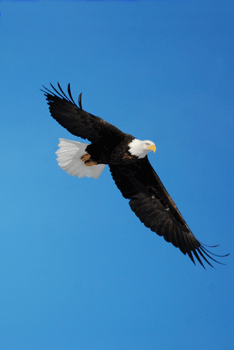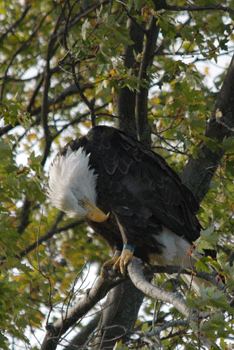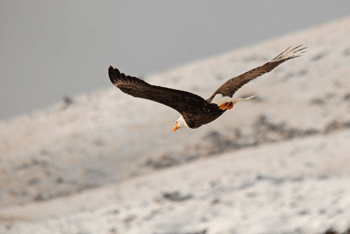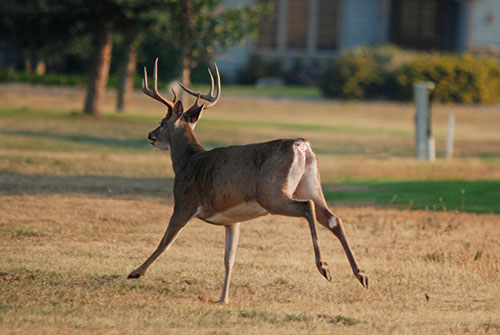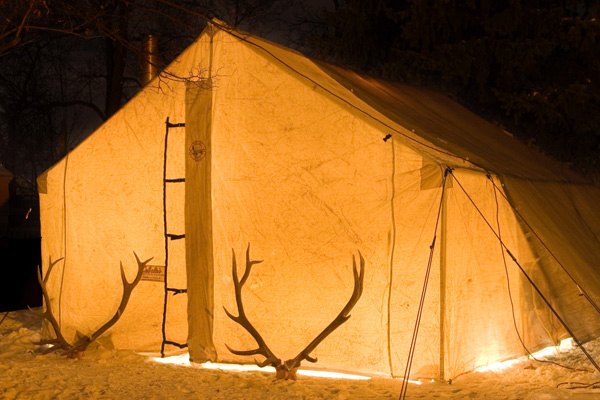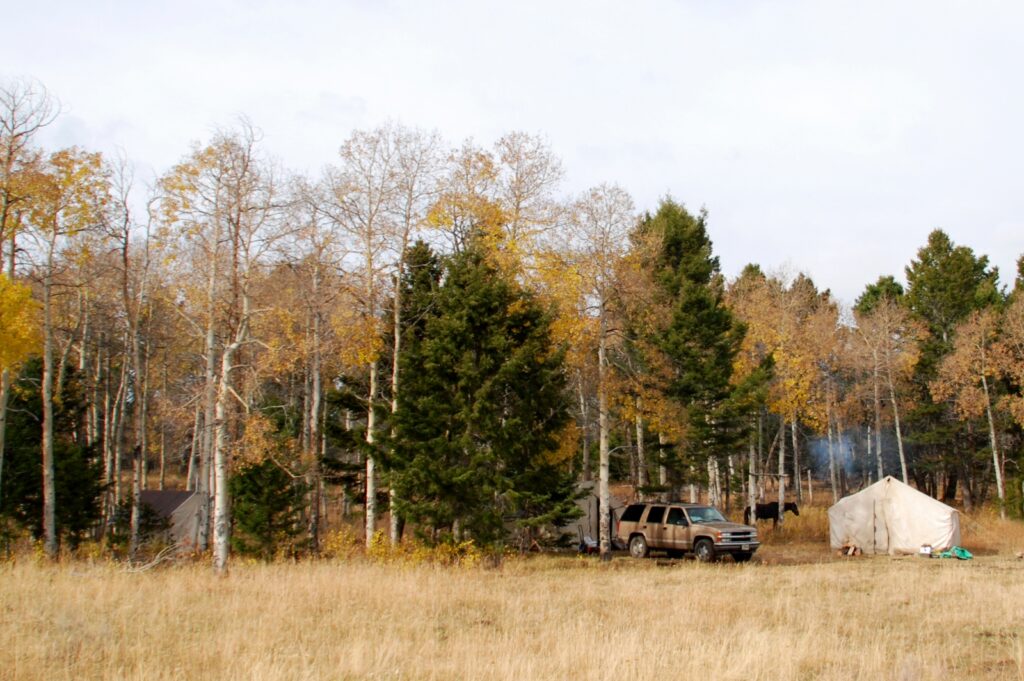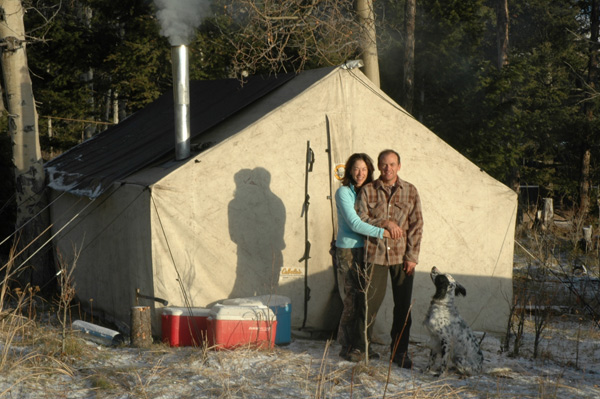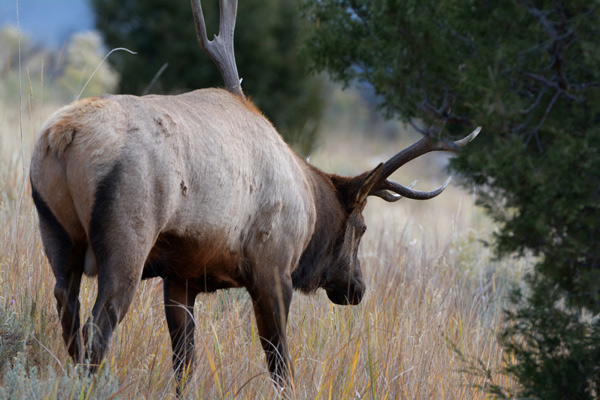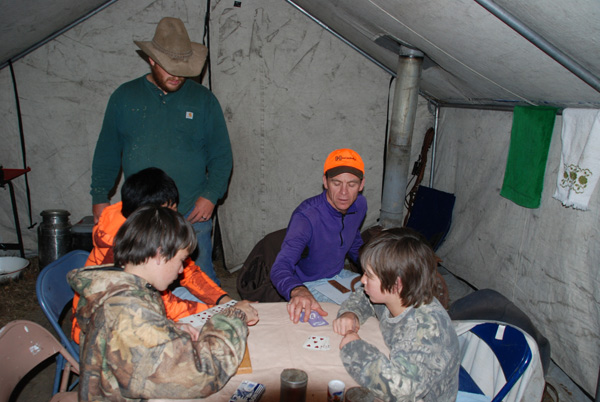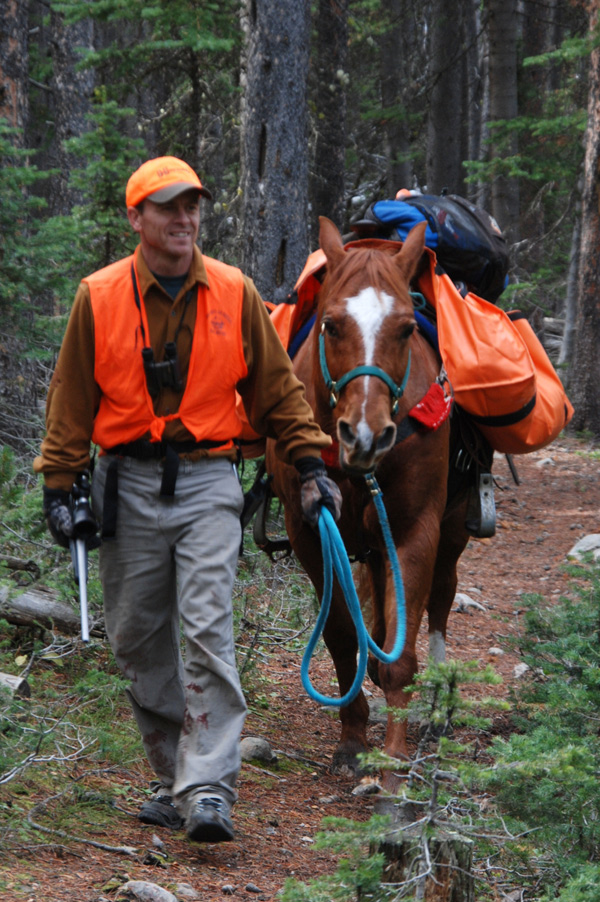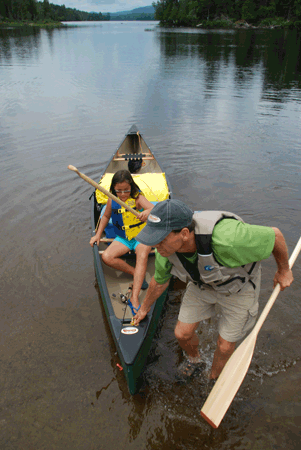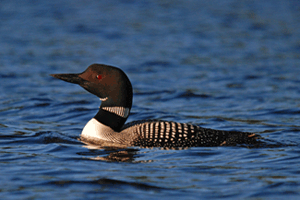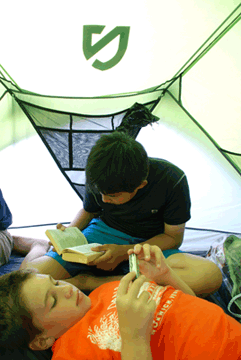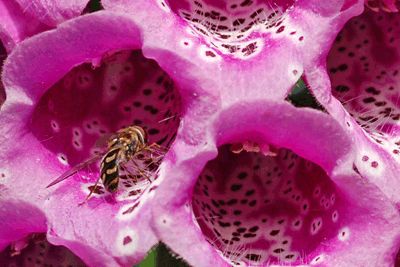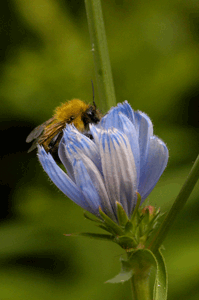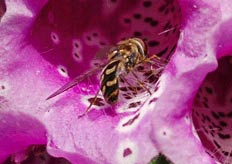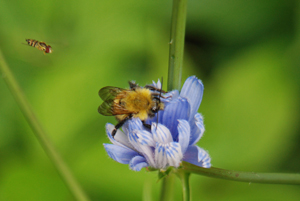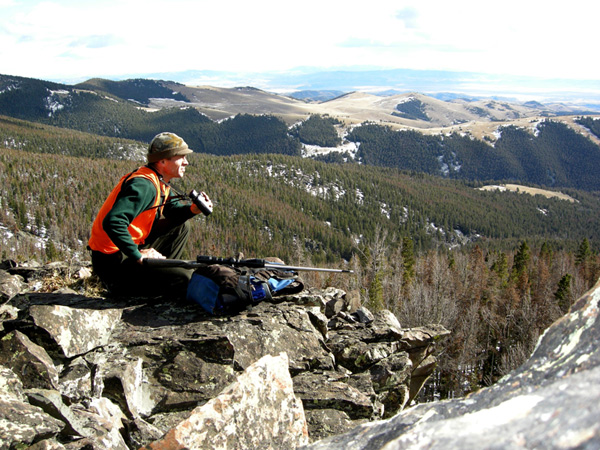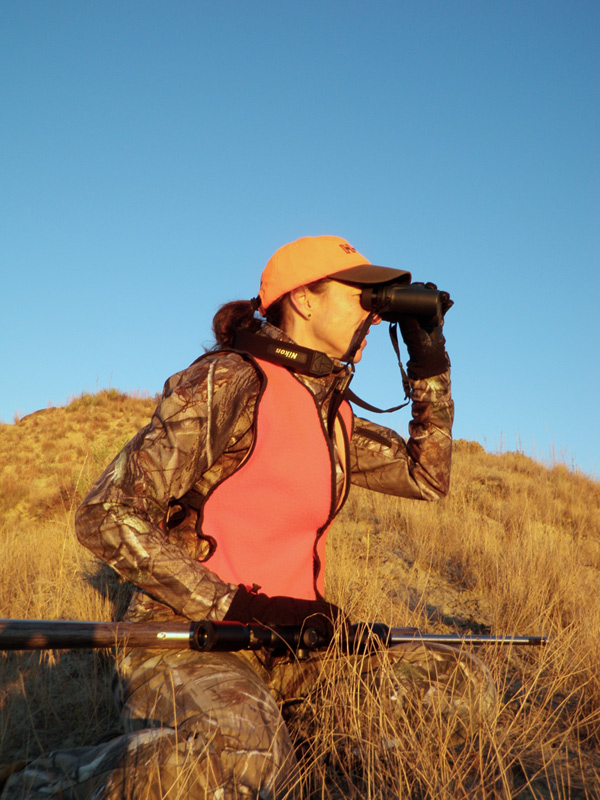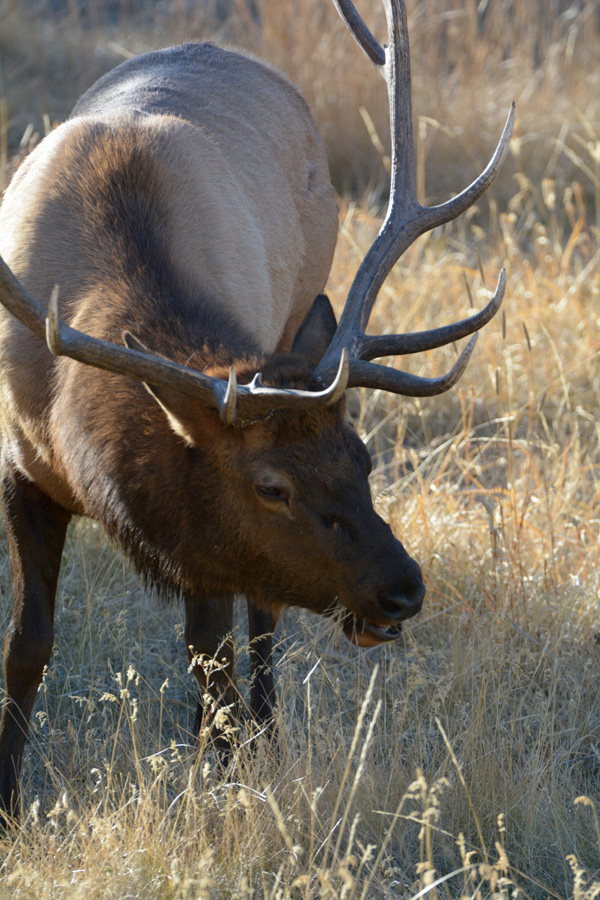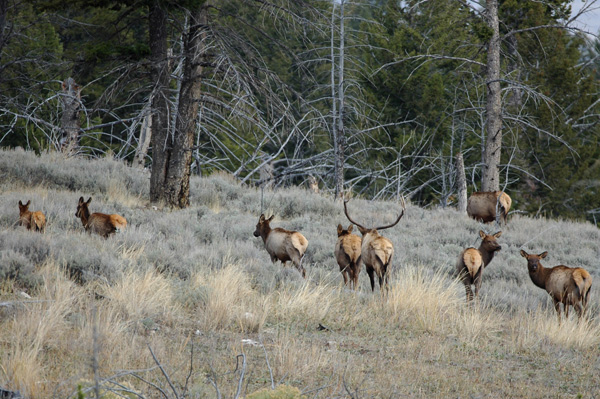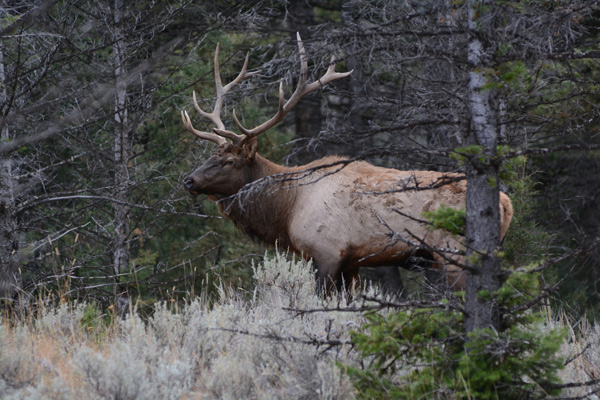Paradise is Personal
© Jack Ballard
“Should we try a different fly?”
It is an undeniable aspect of the human condition that those confronted with a novel situation attempt to resolve it with previous experience. Innumerable studies in human learning have verified this trait across a surfeit of situations, none of which I know have been applied specifically to fly fishing. But perched in a skiff, with the distinct, saline aroma of sea air in my nostrils and an hour of casting without a strike, my question belies three decades of trout fishing and its characteristic mentality.
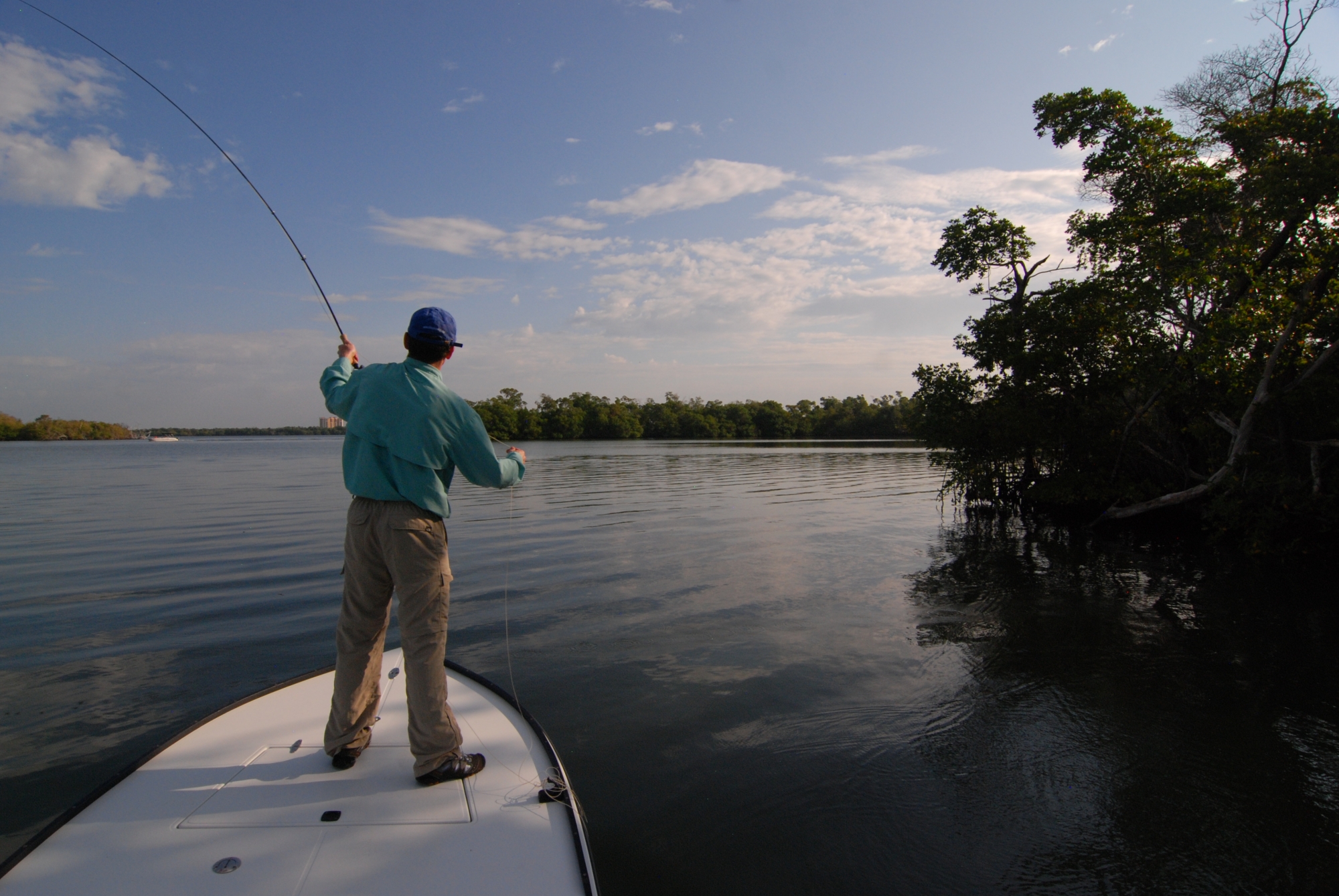
The guide’s steadfast eye’s momentarily illuminate in an uncharacteristic twinkle. He chuckles softly, then dismisses my prior knowledge with a brief lecture.
“That’s what every trout guy thinks down here when the fish aren’t biting. We’re not matching a hatch. When the fish are biting it doesn’t really matter what fly you’re throwing. When they’re not biting it doesn’t matter, either. As long as you’ve got a good pattern in the water, getting it to the fish is way more important.”
Despite the absence of a catch, I’m mightily enjoying a new practice and place. Poled by Steve Bailey, a seasoned local guide, the bow of his spotless white skiff points toward a verdant line of mangroves, the sea-sand interface along a small islet near Sanibel Island, Florida. It’s not that there is a dearth of finned targets for my fly. A little coaching from Steve has helped me discern the outline of fish lying languidly on the shoals near the mangroves. I’ve begun to differentiate the outline of a husky redfish from a streamlined snook.
The guide’s most understated demeanor takes an urgent uptick when he spies what I conjecture is the fin of a small shark cutting smartly through the surface of the water in slightly deeper water. It is rather the dark dorsal fin of a cobia, cruising smartly on a parallel course with the boat. Just at the outer limit of my casting distance, I make my best attempt at the fish. The fly falls just shy of the target. Like a host of other competent trout-takers, I’m quickly confronting my deficiencies as a saltwater angler. The range of my casting is fair, but takes far too much false casting. The rod often drops too low on the forward stroke, resulting in a splashy presentation unfriendly to skittish snook. Accuracy is reasonable, but warrants improvement.
At noon, Steve returns a tired angler and his sweetheart to the sandy shore of a key along the causeway that links Sanibel Island to the mainland at Fort Myers. The morning’s catch has been dismal from the standpoint of size or numbers, likely the result of uncooperative tides and a passing weather system. A couple of small snook don’t make for a boasting post on social media. But it has been a most memorable outing. We watched in awe as a bald eagle boldly stole an osprey’s fish in an aerial display of pursuit and intimidation, snatching the catch directly from the rightful owner’s talons. I made several perfect casts to a variety of fish, one that put the fly within less than a foot of the snout of a large, lounging snook. Steve pronounced the fish’s failure to take the bait, “immoral.” In the words of a most tired cliché, this first foray into saltwater fishing has me hooked, both in terms of the practice and the place.
In geological time, Sanibel’s life as an island spans perhaps a more brief period of time than my morning’s introduction to saltwater fishing. Scientists believe the island was formed around 6,000 years ago, it substrate deposited on the sea bed from sediment borne by the Caloosahatchee River. Currents in the Gulf of Mexico formed the silt into a low-lying island oriented primarily along an east-west axis, an oddity in a region where most islands are aligned north-south. Sanibel takes the shape of a skinny kidney bean or a slightly-flexed index finger, the base of which lies nearest Fort Myers on the mainland, the tip of which separates Sanibel Island from Captiva Island at Blind Pass. Captiva is essentially a sweeping, skinny extension of Sanibel that turns northward. Blind Pass, the shallow cut between the two, has filled with silt on several occasions during the life of the islands, giving credibility to the assertion that the two are but one island ecosystem.
Pine Island, a larger barrier island, lies between the northwest tip of Sanibel and Captiva Island and mainland Florida. Pine Island Sound is located between Sanibel-Captiva and Pine Island, a unique estuary which mingles waters from Charlotte Harbor, San Carlos Bay and the Caloosahatchee River. The sound connects with the Gulf of Mexico via four passes.
Biologists have long recognized estuaries as among the most vibrant ecosystems in the world for numerous forms of life. Pine Island Sound is home to at least 100 invertebrates, numerous species of sharks, more than 150 bird species and a startling 200 different species of fish. In one of the classic movies from the 1990s, Forrest Gump, the protagonist’s mother admonishes him that “life is like a box of chocolates, you never know what you’re going to get.” Casting a fly rod in Pine Island Sound, with its plethora of fish species, is a similar proposition.
Nearly two years to the day after our inaugural visit to Sanibel Island, Lisa and I are cozied up in a beachside condo at Sanibel Arms. We’re honeymooners, married the previous day at the blissfully romantic, relaxing Tarpon Lodge on Pine Island. I count myself among the most fortunate of fellows. My bride is beautiful and intelligent. She is also the perfect outdoor playmate, as enthusiastic about fishing on the honeymoon as her groom.
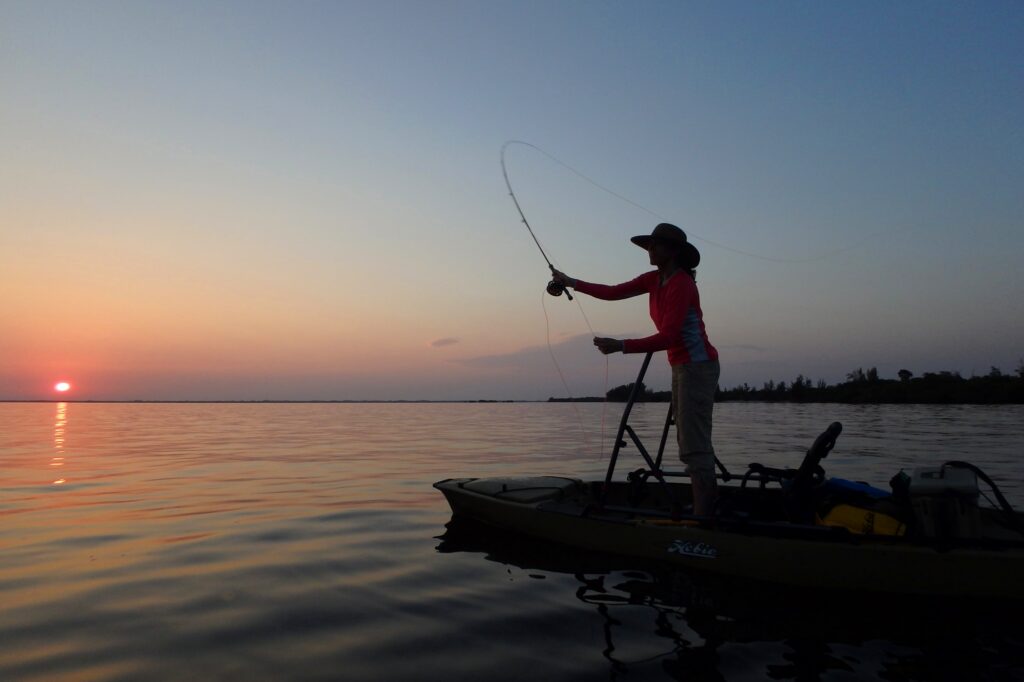
For the next few days we wander our island paradise, searching the beach for sea shells, photographing birds, stuffing ourselves on seafood and, of course, casting for fish in Pine Island Sound. One day we rent Hobie fishing kayaks, another I fish from Sanibel’s beaches at dawn while Lisa sleeps in. True to form, our catch composes a wide array of fish: pompano, ladyfish, spotted seatrout, redfish, blue runner, snook, a hardhead catfish, a couple of pesky needlefish and even a squatty little puffer that grabbed a Clouser minnow.
It’s a heady, fascinating education in saltwater fish. We dutifully photograph each species to identify those with which we’re not familiar. Much like the neophyte trout angler in the Rocky Mountains whose face lights up with the catching of a diminutive brook trout or a foot-long rainbow, we’re just happy to be there, to find ourselves thoroughly though unsophisticatedly enmeshed in a novel pursuit.
Over time, trout-chasing newbies naturally develop preferences and aspirations more in line with veterans of the sport. Honeymoon complete, I’ve landed enough fish in the saline waters adjacent Sanibel Island to develop some distinct preferences. I am keenly motivated by the challenge of sight-casting to a single fish. So far, the specimens we’ve landed of those species most often associated with sport angling (redfish, snook, seatrout) have been modest in size. Weather conditions and tides, I’ve discovered, play a pivotal role in creating prime conditions for better than average fish. Departing the island in my mother-in-law’s borrowed car on the causeway, I take a longing look through the driver’s window at the wind-riffled waters toward Pine Island Sound and hatch a plan for a return trip. An anniversary getaway, perhaps?
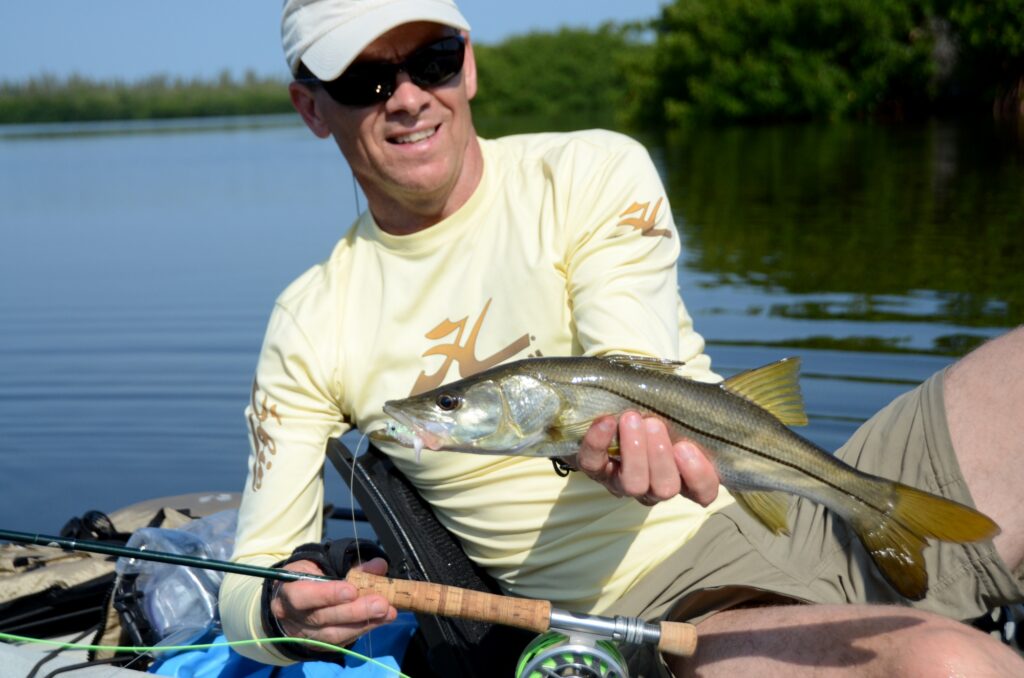
With a Sanibel stay booked for our second wedding anniversary, a fortuitous turn of events finds me fishing Pine Island Sound four months before the anticipated event. A winter board meeting of the Outdoor Writers Association of America, of which my wife is President, lands us at Tween the Waters Resort on Captiva Island in mid-January for a board meeting. One day is reserved for angling.
The weather is truly wretched for fishing. A sustained cold front has dropped water temperature by 11 degrees in as many days. The nighttime low plummets to the low 50s. Fishing day dawns chilly, a dull gray sky overhead and a soft, but biting breeze necessitating a jacket for Florida fishing. I’ll be fishing with Kris Millgate, a friend and video producer from Idaho in the morning, also here for the board meeting. In the afternoon I’m scheduled on the local guide’s skiff with a photographer and a writer from the News-Press, the dominant newspaper in Fort Myers. They’re slated to do a lifestyle piece on saltwater fly fishing. I’m the reluctant subject for the story. We will be fishing in conditions the guide flatly describes as “tough.”
By 11 a. m. Kris and I have shed our jackets, two northerners finding this unseasonably cold morning in January perfectly pleasant. The clouds have dissipated somewhat, making it a bit easier to see into the water. But we’re having poor success finding fish, less luck catching them. We return to the resort’s dock at noon. A single, small snook took my fly in late morning, our sole fish for the morning. On the bright side, I’ve had a couple hours to polish a rusty casting stroke. If the guide can find a fish this afternoon, I’m far less likely to botch the opportunity with an errant cast.
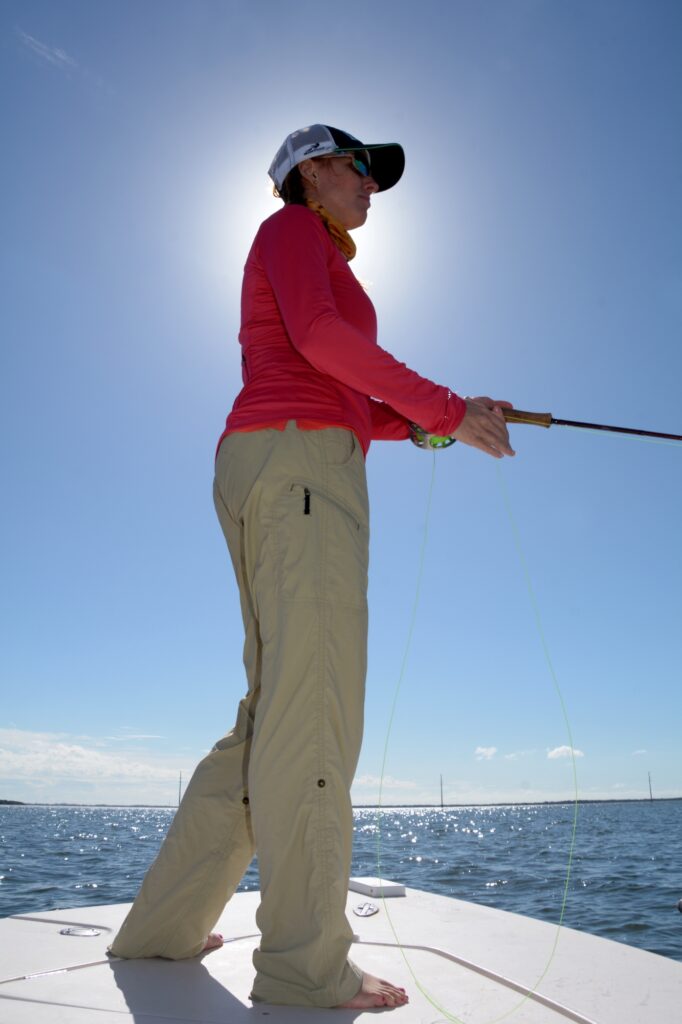
We launch after lunch. On the boat with guide, Ozzie Lessinger, and myself are Laura and Ricardo, writer and photographer. For the next two hours we scour the flats in Pine Island Sound, just northeast of Sanibel Island. Visibility is obscured by choppy water and clouds. Ozzie and I are plied with a thousand questions. Why fly fishing? How does it work? Why here?
The editorial duo seems fascinated with the art of casting. I explain to them that sight fishing is, in my mind, the fly angler’s equivalent to another of my passions, elk hunting: spot the quarry, compose a perfect stalk and make the shot. Ozzie appraises them of the area’s attraction as a fishing destination. “We’re not as well-known as the Florida Keys, but Southwest Florida is the premier destination in the world for tarpon fishing.” Lessinger explains that the gargantuan, migratory tarpon usually show up in early May, along with a flush of outsized snook. But the Sanibel area is also a year-round fishery, thanks to an abundance of resident species like the snook, redfish and spotted seatrout we’re seeking. Some tarpon are also year-round residents.
Ozzie’s watchful eyes are tuned to every hint of a target. We pole past an oyster bar, where he instructs me to shoot a few casts into water that often holds redfish. He scrutinizes a large, passing ray, telling our observers that game fish sometimes follow rays in search of crustaceans they dislodge from the bottom. He finally focuses on a particular flat, concluding that a methodical coverage of this habitat, much like a refined pointing dog working a cover, will be our best chance of success.
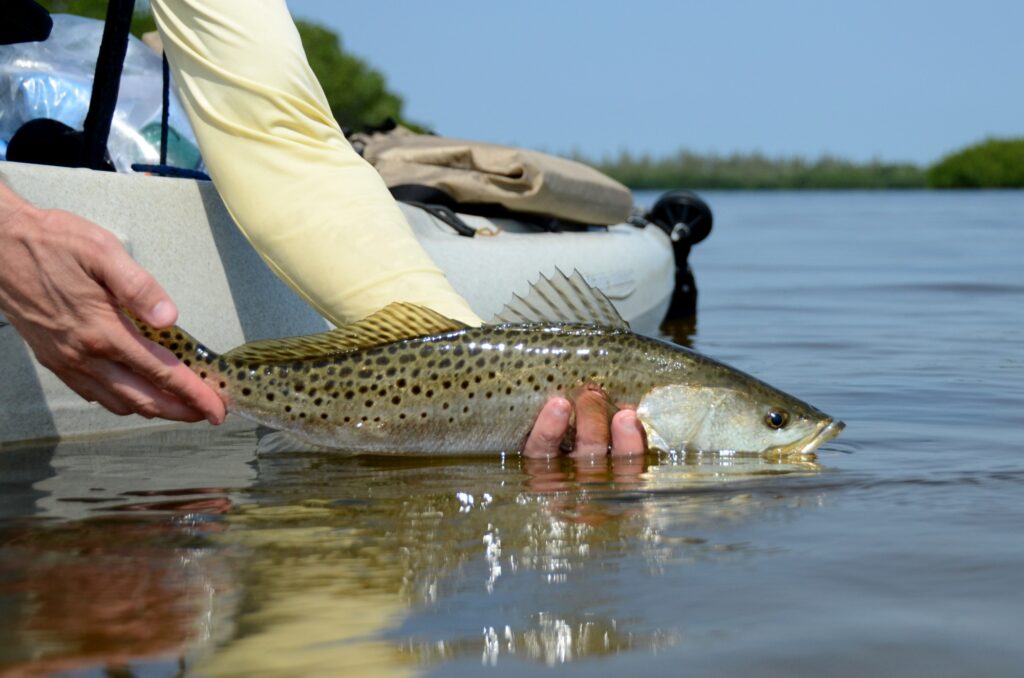
Our efforts remain scuttled by cloud cover and wind. Ozzie sights some fish from the poling platform; I spot a few from the bow. But by the time they’re spied, the skiff is already too close. In most cases we spot the forms as they’re finning away. I catch a glimpse of a pod of redfish moving out of range. Ozzie grimaces when the long, broad body of a husky snook scoots from a patch of sunlit water into the shadows.
My chance arrives when the clouds dissipate and the breeze begins to abate. The sharp eyes of the guide detect two redfish off the bow, close enough for a cast. But by the time I’m on them the pair whisks away. A few minutes later Ozzie sees three more reds at 12 o’clock. It will be a tricky. There’s no time to re-position the boat. My backcast will pass directly over the photographer and scribe huddled behind me, and close to the poling platform.
“Don’t blow it!” I chide myself as the leader unfurls. The rod bends backward with the weight of the line. I press my elbow to ribcage, drive the butt of the Winston 8-weight forward and stop my taut wrist at 10 o’clock. Green line shoots through the guides. Before the fly reaches the water I know it’s a good cast.
A little too good, in fact. The fly lands a foot beyond the snout of the shouldered redfish facing the boat. I strip frantically to keep the fly from tickling the back of the drum, now extremely thankful for the chop on the water that impedes the fish’s vision as well as my own.
Clear of the fish, I let the fly sink within eyeshot of the lounging red, then strip toward the boat. The predator suddenly comes to life, lunging after the fly, missing it in two wild gulps. But I see its mouth close around the yellow-orange minnow on the third and strip mightily to make the set.
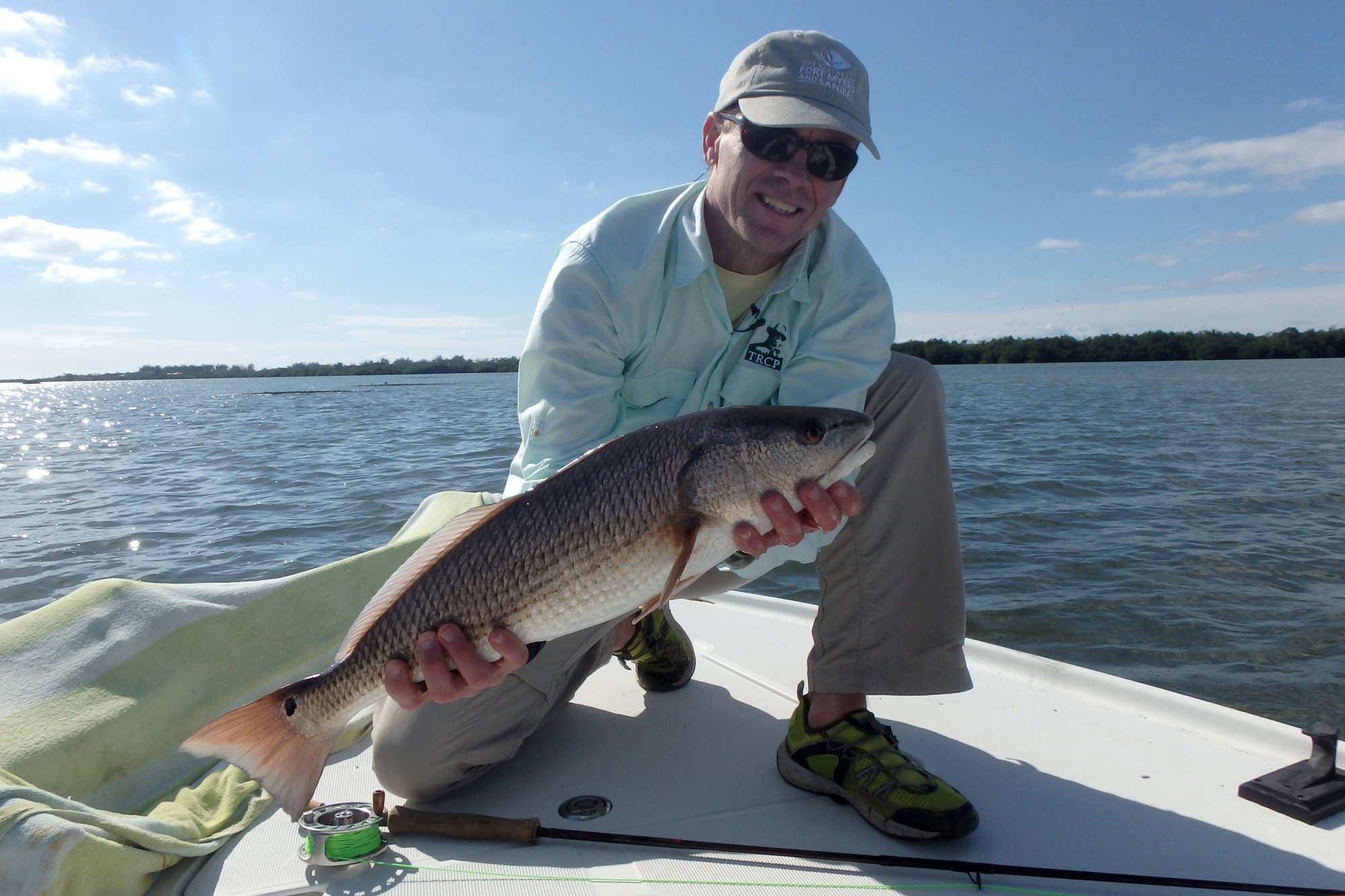
“Nice work,” hollers a grinning guide from the rear of the boat.
I’m not quite ready to celebrate. Odds are very high it will be the only fish of the afternoon. It surges strongly on the first run and I can’t bear to lose it.
But after a sustained tussle Ozzie grasps the leader and brings the fish to skiff. The reporter wants a measurement. A tape shows 25 inches from nose to tail, not the biggest redfish in the water, but a very fine catch in challenging conditions. Documentary photos of the occasion show the angler with a broad smile.
In late April we’re back on Sanibel. The fishing component of the nuptials anniversary will be a multi-day kayaking adventure on segments of the Great Calusa Blueway, a paddling “trail” spanning 190 miles in the bays, rivers and estuaries in the Fort Myers area. A substantial portion of it is found in Pine Island Sound. From the eastern end of Sanibel Island the Blueway winds westward, hugging the shoreline of the island, then ducking into Tarpon Bay before exiting to skirt a seemingly endless array of mangrove islets in the J. N. “Ding” Darling National Wildlife Refuge. The route turns north toward the end of Sanibel, passes along the west side of Captiva and North Captiva Islands, eventually crossing the northern end of the sound to arrive on the west side of Pine Island.
Anglers on the Blueway, we discover, aren’t so much confronted with the question of “where to fish” but “where not to fish.” After a pre-dawn launch the first morning, our progress comes to a standstill at a tiny island drooped with a canopy of strident green mangroves, their ochre roots clutching gamely to a scaly bar not much larger than the concrete slab of a two-car garage. We catch a handful of seatrout near the islet. Casting toward the mangroves, I’m rewarded with the aggressive take of a burly redfish.
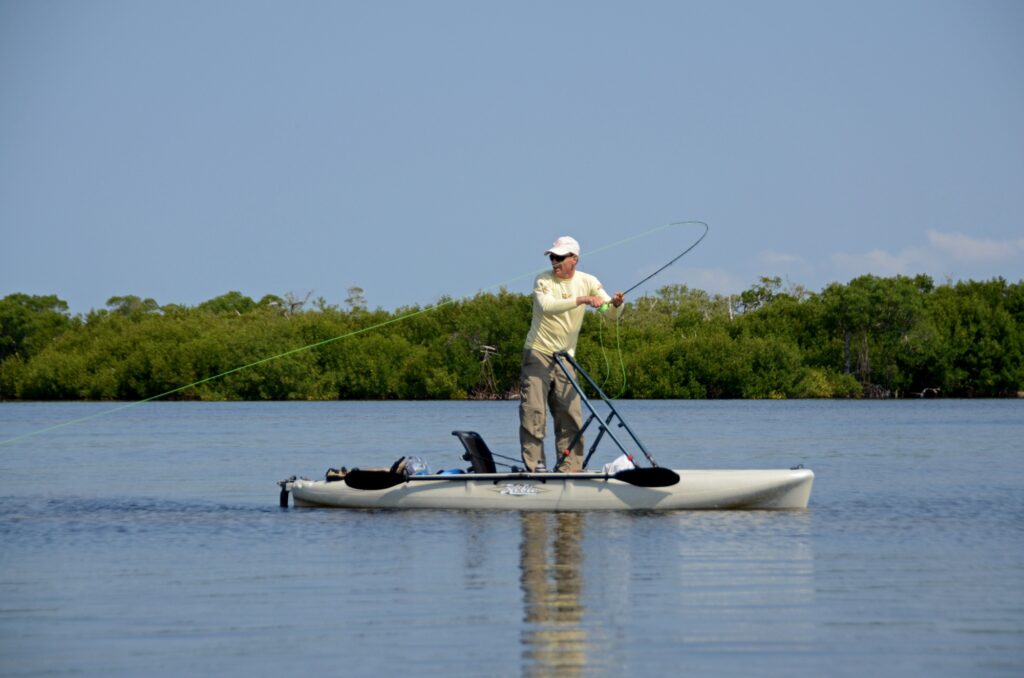
The entirety of Pine Island Sound was designated as an Aquatic Preserve in 1970. Motorized craft are welcome, but their speed is regulated in many places to protect manatees and the seagrass habitat from gnawing propellers. Duck into a cove and it may mark the gateway to a veritable labyrinth of mangroves, inhabited by birds, crabs, redfish and snook. Prowl the shoreline and you’re apt to have more close encounters with herons, ibises and seatrout than boats. One of Sanibel’s finest attractions is the ability to be engulfed in solitude so close to such charming island inhabitation. By early afternoon a relentless sun and heightening heat chase us from the water. We return to the condo, take a late lunch indoors and contemplate a closure to the day. Perhaps we’ll eat an early dinner at one of the island’s many fine restaurants and then wander Lighthouse Beach in search of shells. Another option is to play tennis or cruise an island path on bicycles, then dine at a later hour. Tomorrow? That’s easy. We’ll embark on a similar itinerary, relishing just another day in paradise.


